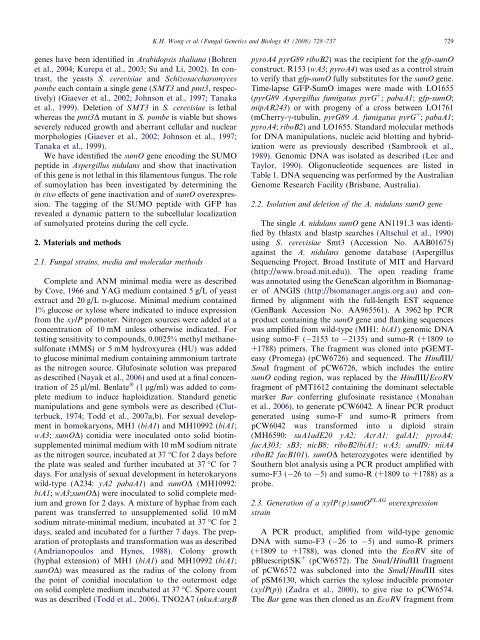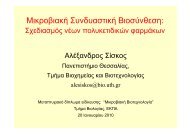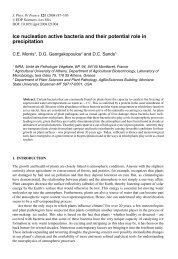Sumoylation in Aspergillus nidulans: sumO inactivation ...
Sumoylation in Aspergillus nidulans: sumO inactivation ...
Sumoylation in Aspergillus nidulans: sumO inactivation ...
Create successful ePaper yourself
Turn your PDF publications into a flip-book with our unique Google optimized e-Paper software.
K.H. Wong et al. / Fungal Genetics and Biology 45 (2008) 728–737 729<br />
genes have been identified <strong>in</strong> Arabidopsis thaliana (Bohren<br />
et al., 2004; Kurepa et al., 2003; Su and Li, 2002). In contrast,<br />
the yeasts S. cerevisiae and Schizosaccharomyces<br />
pombe each conta<strong>in</strong> a s<strong>in</strong>gle gene (SMT3 and pmt3, respectively)<br />
(Giaever et al., 2002; Johnson et al., 1997; Tanaka<br />
et al., 1999). Deletion of SMT3 <strong>in</strong> S. cerevisiae is lethal<br />
whereas the pmt3D mutant <strong>in</strong> S. pombe is viable but shows<br />
severely reduced growth and aberrant cellular and nuclear<br />
morphologies (Giaever et al., 2002; Johnson et al., 1997;<br />
Tanaka et al., 1999).<br />
We have identified the <strong>sumO</strong> gene encod<strong>in</strong>g the SUMO<br />
peptide <strong>in</strong> <strong>Aspergillus</strong> <strong>nidulans</strong> and show that <strong>in</strong>activation<br />
of this gene is not lethal <strong>in</strong> this filamentous fungus. The role<br />
of sumoylation has been <strong>in</strong>vestigated by determ<strong>in</strong><strong>in</strong>g the<br />
<strong>in</strong> vivo effects of gene <strong>in</strong>activation and of <strong>sumO</strong> overexpression.<br />
The tagg<strong>in</strong>g of the SUMO peptide with GFP has<br />
revealed a dynamic pattern to the subcellular localization<br />
of sumolyated prote<strong>in</strong>s dur<strong>in</strong>g the cell cycle.<br />
2. Materials and methods<br />
2.1. Fungal stra<strong>in</strong>s, media and molecular methods<br />
Complete and ANM m<strong>in</strong>imal media were as described<br />
by Cove, 1966 and YAG medium conta<strong>in</strong>ed 5 g/L of yeast<br />
extract and 20 g/L D-glucose. M<strong>in</strong>imal medium conta<strong>in</strong>ed<br />
1% glucose or xylose where <strong>in</strong>dicated to <strong>in</strong>duce expression<br />
from the xylP promoter. Nitrogen sources were added at a<br />
concentration of 10 mM unless otherwise <strong>in</strong>dicated. For<br />
test<strong>in</strong>g sensitivity to compounds, 0.0025% methyl methanesulfonate<br />
(MMS) or 5 mM hydroxyurea (HU) was added<br />
to glucose m<strong>in</strong>imal medium conta<strong>in</strong><strong>in</strong>g ammonium tartrate<br />
as the nitrogen source. Glufos<strong>in</strong>ate solution was prepared<br />
as described (Nayak et al., 2006) and used at a f<strong>in</strong>al concentration<br />
of 25 ll/ml. Benlate Ò (1 lg/ml) was added to complete<br />
medium to <strong>in</strong>duce haploidization. Standard genetic<br />
manipulations and gene symbols were as described (Clutterbuck,<br />
1974; Todd et al., 2007a,b). For sexual development<br />
<strong>in</strong> homokaryons, MH1 (biA1) and MH10992 (biA1;<br />
wA3; <strong>sumO</strong>D) conidia were <strong>in</strong>oculated onto solid biot<strong>in</strong>supplemented<br />
m<strong>in</strong>imal medium with 10 mM sodium nitrate<br />
as the nitrogen source, <strong>in</strong>cubated at 37 °C for 2 days before<br />
the plate was sealed and further <strong>in</strong>cubated at 37 °C for 7<br />
days. For analysis of sexual development <strong>in</strong> heterokaryons<br />
wild-type (A234: yA2 pabaA1) and <strong>sumO</strong>D (MH10992:<br />
biA1; wA3;<strong>sumO</strong>D) were <strong>in</strong>oculated to solid complete medium<br />
and grown for 2 days. A mixture of hyphae from each<br />
parent was transferred to unsupplemented solid 10 mM<br />
sodium nitrate-m<strong>in</strong>imal medium, <strong>in</strong>cubated at 37 °C for 2<br />
days, sealed and <strong>in</strong>cubated for a further 7 days. The preparation<br />
of protoplasts and transformation was as described<br />
(Andrianopoulos and Hynes, 1988). Colony growth<br />
(hyphal extension) of MH1 (biA1) and MH10992 (biA1;<br />
<strong>sumO</strong>D) was measured as the radius of the colony from<br />
the po<strong>in</strong>t of conidial <strong>in</strong>oculation to the outermost edge<br />
on solid complete medium <strong>in</strong>cubated at 37 °C. Spore count<br />
was as described (Todd et al., 2006). TNO2A7 (nkuA:argB<br />
pyroA4 pyrG89 riboB2) was the recipient for the gfp-<strong>sumO</strong><br />
construct. R153 (wA3; pyroA4) was used as a control stra<strong>in</strong><br />
to verify that gfp-<strong>sumO</strong> fully substitutes for the <strong>sumO</strong> gene.<br />
Time-lapse GFP-SumO images were made with LO1655<br />
(pyrG89 <strong>Aspergillus</strong> fumigatus pyrG + ; pabaA1; gfp-<strong>sumO</strong>;<br />
mipAR243) or with progeny of a cross between LO1761<br />
(mCherry-c-tubul<strong>in</strong>, pyrG89 A. fumigatus pyrG + ; pabaA1;<br />
pyroA4; riboB2) and LO1655. Standard molecular methods<br />
for DNA manipulations, nucleic acid blott<strong>in</strong>g and hybridization<br />
were as previously described (Sambrook et al.,<br />
1989). Genomic DNA was isolated as described (Lee and<br />
Taylor, 1990). Oligonucleotide sequences are listed <strong>in</strong><br />
Table 1. DNA sequenc<strong>in</strong>g was performed by the Australian<br />
Genome Research Facility (Brisbane, Australia).<br />
2.2. Isolation and deletion of the A. <strong>nidulans</strong> <strong>sumO</strong> gene<br />
The s<strong>in</strong>gle A. <strong>nidulans</strong> <strong>sumO</strong> gene AN1191.3 was identified<br />
by tblastx and blastp searches (Altschul et al., 1990)<br />
us<strong>in</strong>g S. cerevisiae Smt3 (Accession No. AAB01675)<br />
aga<strong>in</strong>st the A. <strong>nidulans</strong> genome database (<strong>Aspergillus</strong><br />
Sequenc<strong>in</strong>g Project. Broad Institute of MIT and Harvard<br />
(http://www.broad.mit.edu)). The open read<strong>in</strong>g frame<br />
was annotated us<strong>in</strong>g the GeneScan algorithm <strong>in</strong> Biomanager<br />
of ANGIS (http://biomanager.angis.org.au) and confirmed<br />
by alignment with the full-length EST sequence<br />
(GenBank Accession No. AA965561). A 3962 bp PCR<br />
product conta<strong>in</strong><strong>in</strong>g the <strong>sumO</strong> gene and flank<strong>in</strong>g sequences<br />
was amplified from wild-type (MH1: biA1) genomic DNA<br />
us<strong>in</strong>g sumo-F ( 2153 to 2135) and sumo-R (+1809 to<br />
+1788) primers. The fragment was cloned <strong>in</strong>to pGEMTeasy<br />
(Promega) (pCW6726) and sequenced. The H<strong>in</strong>dIII/<br />
SmaI fragment of pCW6726, which <strong>in</strong>cludes the entire<br />
<strong>sumO</strong> cod<strong>in</strong>g region, was replaced by the H<strong>in</strong>dIII/EcoRV<br />
fragment of pMT1612 conta<strong>in</strong><strong>in</strong>g the dom<strong>in</strong>ant selectable<br />
marker Bar conferr<strong>in</strong>g glufos<strong>in</strong>ate resistance (Monahan<br />
et al., 2006), to generate pCW6042. A l<strong>in</strong>ear PCR product<br />
generated us<strong>in</strong>g sumo-F and sumo-R primers from<br />
pCW6042 was transformed <strong>in</strong>to a diploid stra<strong>in</strong><br />
(MH6590: suA1adE20 yA2; AcrA1; galA1; pyroA4;<br />
facA303; sB3; nicB8; riboB2/biA1; wA3; amdI9; niiA4<br />
riboB2 facB101). <strong>sumO</strong>D heterozygotes were identified by<br />
Southern blot analysis us<strong>in</strong>g a PCR product amplified with<br />
sumo-F3 ( 26 to 5) and sumo-R (+1809 to +1788) as a<br />
probe.<br />
2.3. Generation of a xylP(p)<strong>sumO</strong> FLAG overexpression<br />
stra<strong>in</strong><br />
A PCR product, amplified from wild-type genomic<br />
DNA with sumo-F3 ( 26 to 5) and sumo-R primers<br />
(+1809 to +1788), was cloned <strong>in</strong>to the EcoRV site of<br />
pBluescriptSK + (pCW6572). The SmaI/H<strong>in</strong>dIII fragment<br />
of pCW6572 was subcloned <strong>in</strong>to the SmaI/H<strong>in</strong>dIII sites<br />
of pSM6130, which carries the xylose <strong>in</strong>ducible promoter<br />
(xylP(p)) (Zadra et al., 2000), to give rise to pCW6574.<br />
The Bar gene was then cloned as an EcoRV fragment from









